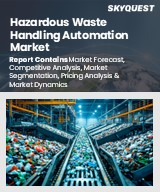
세계의 유해 폐기물 처리 자동화 시장 규모는 2023년에 97억 달러로 평가되며, 2024년 100억 6,000만 달러에서 2032년에는 134억 5,000만 달러로 성장하며, 예측 기간(2025-2032년)의 CAGR은 3.7%로 성장할 전망입니다.
세계 유해 폐기물 처리 자동화 시장은 위험 물질의 안전한 폐기에 대한 규제 요구 증가, 산업 폐기물 생산량 급증, 환경 및 근로자 안전에 대한 관심 증가 등 몇 가지 주요 요인에 의해 주도되고 있습니다. 강화된 로봇 공학 및 자동화 기술은 업무 효율성을 촉진하고, 지속가능성 운동은 산업계가 폐기물 관리 프로세스 개선을 위한 자동화 시스템을 도입하도록 장려하고 있습니다. 직원의 안전을 높이고 유해 물질에 대한 인체 노출을 줄이려는 움직임은 자동화를 더욱 촉진할 것입니다. AI, IoT, 머신비전의 혁신은 이러한 시스템의 신뢰성을 높입니다. 그럼에도 불구하고 막대한 초기 자본 투자, 인식 및 전문 지식 부족, 엄격한 규제 승인, 기존 수동 프로세스와의 통합의 어려움 등의 문제로 인해 현재로서는 광범위한 채택을 가로막고 있습니다.
Global Hazardous Waste Handling Automation Market size was valued at USD 9.7 billion in 2023 and is poised to grow from USD 10.06 billion in 2024 to USD 13.45 billion by 2032, growing at a CAGR of 3.7% during the forecast period (2025-2032).
The global hazardous waste handling automation market is propelled by several significant factors, including increasing regulatory demands for the secure disposal of hazardous materials, escalating industrial waste production, and a growing emphasis on environmental and worker safety. Enhanced robotics and automation technologies are fostering operational efficiency, while the sustainability movement encourages industries to adopt automated systems for improved waste management processes. The drive for greater employee safety and decreased human exposure to hazardous substances further promotes automation. Innovations in AI, IoT, and machine vision enhance the reliability of these systems. Nevertheless, challenges such as substantial initial capital investments, a lack of awareness and expertise, stringent regulatory approvals, and integration difficulties with existing manual processes currently impede broader adoption.
Top-down and bottom-up approaches were used to estimate and validate the size of the Global Hazardous Waste Handling Automation market and to estimate the size of various other dependent submarkets. The research methodology used to estimate the market size includes the following details: The key players in the market were identified through secondary research, and their market shares in the respective regions were determined through primary and secondary research. This entire procedure includes the study of the annual and financial reports of the top market players and extensive interviews for key insights from industry leaders such as CEOs, VPs, directors, and marketing executives. All percentage shares split, and breakdowns were determined using secondary sources and verified through Primary sources. All possible parameters that affect the markets covered in this research study have been accounted for, viewed in extensive detail, verified through primary research, and analyzed to get the final quantitative and qualitative data.
Global Hazardous Waste Handling Automation Market Segments Analysis
Global Hazardous Waste Handling Automation Market is segmented by Type, Application, Automation and region. Based on Type, the market is segmented into Chemical Waste, Biological Waste, Radioactive Waste and Electronic Waste. Based on Application, the market is segmented into Waste Collection, Waste Treatment, Waste Disposal and Waste Recycling. Based on Automation, the market is segmented into Robotic Automation, Conveyor Systems, Automated Guided Vehicles and Drones. Based on region, the market is segmented into North America, Europe, Asia Pacific, Latin America and Middle East & Africa.
Driver of the Global Hazardous Waste Handling Automation Market
The increasing enforcement of stringent global environmental regulations concerning hazardous waste disposal is driving the demand for advanced automation solutions in this sector. Governments are establishing compliance requirements that necessitate the adoption of sophisticated automated systems, aimed at reducing human exposure and mitigating environmental risks. These automated processes are not only designed to enhance operational efficiency but also to ensure adherence to evolving regulatory frameworks, thereby helping organizations avoid potential penalties associated with non-compliance. As the landscape of waste management continues to shift, the reliance on automated solutions becomes crucial for sustainable and responsible hazardous waste handling.
Restraints in the Global Hazardous Waste Handling Automation Market
The global hazardous waste handling automation market faces significant challenges related to high capital expenditures associated with the installation of advanced technologies, such as robotics and AI integration, as well as necessary infrastructure updates. This financial burden often acts as a deterrent for small and medium-sized enterprises, which struggle to invest in such extensive automation. As a result, the market is predominantly controlled by larger corporations, creating a disparity in operational efficiency and compliance with regulations. This dynamic leaves smaller companies at a disadvantage, unable to fully leverage the benefits of automation in their hazardous waste management processes.
Market Trends of the Global Hazardous Waste Handling Automation Market
The Global Hazardous Waste Handling Automation market is experiencing a significant shift towards AI-driven predictive waste management solutions. This trend highlights the increasing reliance on artificial intelligence to forecast equipment failures and streamline waste collection processes, ensuring both safety and efficiency. By minimizing human exposure to hazardous environments and optimizing operational uptime, intelligent systems are becoming essential tools for industries striving for enhanced regulatory compliance and cost efficiencies. As demand grows for innovative, automated solutions that address these critical safety and operational challenges, the market for hazardous waste handling automation is poised for substantial expansion and technological advancement.